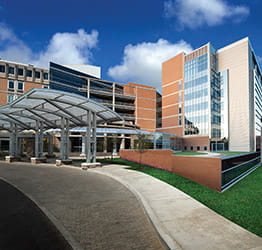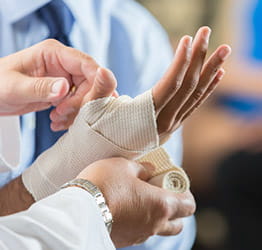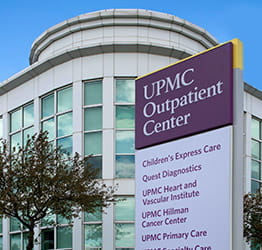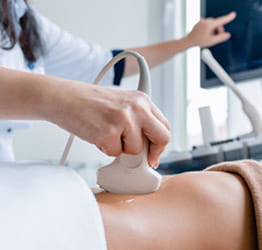
8/21/2025
PITTSBURGH – New research from the University of Pittsburgh School of Medicine and Cambridge University upends a long-standing belief about brain plasticity.
A study published today in Nature Neuroscience shows that the brain’s built-in “body map” remains stable even when the body undergoes drastic changes, such as the loss of a limb.
The findings have implications for the treatment of “phantom limb” pain and suggest that achieving reliable restoration of sensation and controlling robotic replacement limbs via brain-computer interfaces may be more viable in the long-term than previously thought.
“This study is a powerful reminder that even after limb loss, the brain holds onto the body, waiting to reconnect,” said lead author Hunter Schone, Ph.D., postdoctoral research fellow at Pitt Rehab Neural Engineering Labs.
Foundational neuroscience research has shown that the somatosensory cortex – an area of the brain located just behind the frontal lobe – holds a rich and complex map of the body, with different regions corresponding to different body parts. The region corresponding to the hand and fingers, for example, lays next to the area representing lips, nose and eyes.
These maps are responsible for processing sensory information, such as touch, temperature and pain, as well as body position. For example, touching something hot with the hand activates a brain region just above the ear.
For decades, neuroscientists thought that losing a limb caused the brain’s body map to reorganize. Neighboring regions would invade and repurpose the brain area that previously represented the now amputated limb, the old thinking went. But this theory has long conflicted with patient experiences as many people continue to feel vivid sensations of their missing limbs. Adding to the puzzle, previous brain imaging studies have shown that when individuals who have had an amputation attempt to move their phantom limbs, their brain activation patterns closely resemble those of able-bodied individuals.
To investigate this contradiction, a team led by Tamar Makin, Ph.D., professor of cognitive neuroscience at the University of Cambridge, followed three individuals due to undergo amputation of one of their hands – the first time a study has looked at the hand and face maps of individuals both before and after amputation. Most of the work was carried out while Makin and Schone were at University College London.
Researchers asked study participants to move, or attempt moving, their fingers and purse their lips while lying in a magnetic resonance imaging (MRI) scanner. These functional MRI scans were taken prior to the planned hand amputation and then again three and six months after surgery. One participant was scanned again 18 months after amputation and a second participant five years after amputation.
 Analysis of the ‘before’ and ‘after’ images revealed remarkable consistency: even with their hand now missing, the corresponding brain region activated in an almost identical manner.
Analysis of the ‘before’ and ‘after’ images revealed remarkable consistency: even with their hand now missing, the corresponding brain region activated in an almost identical manner.
“Because of our previous work, we suspected that the brain maps would be largely unchanged, but the extent to which the map of the missing limb remained intact was jaw-dropping,” Makin said. “Bearing in mind that the somatosensory cortex is responsible for interpreting what’s going on within the body, it seems astonishing that it doesn’t seem to know that the hand is no longer there.”
Researchers also confirmed that the region corresponding to the lips had not taken over the region representing the missing hand, disproving long-held assumptions that the body map can drastically reorganize.
The researchers think that the misconception comes from methodology flaws. While the brain does have a map of the body, each part of the map doesn’t support one body part exclusively – which is why activity from neighboring areas on the map could be misinterpreted as taking over.
Study findings also explain why treatment approaches focusing on restoring representation of the limb in the brain’s map have shown limited success for phantom limb pain – perhaps they tackled the wrong problem. The most promising therapies involve rethinking how the amputation surgery is performed, scientists say.
Reconnecting remaining parts of the nerves inside the residual limb to new muscle or skin could stop the nerves from sending signals that contribute to the feeling of pain back to the brain. Anecdotally, of the three participants, all of whom had substantial limb pain prior to amputation, one received a complex procedure to graft the nerves to new muscle. That participant is now pain-free.
Not only does the study challenge a long-held belief about brain plasticity, but it also suggests that restoring movement or sensation to a paralyzed limb or a prosthetic controlled by brain-computer interface – the kind of work spearheaded by researchers at Pitt Rehab Neural Engineering Labs -- is possible in the long-term.
“Now that we’ve shown these maps are stable, brain-computer interface technologies can operate under the assumption that the body map remains consistent over time,” said Schone. “This allows us to move into the next frontier: accessing finer details of the hand map, like distinguishing the tip of the finger from the base, and restoring the rich, qualitative aspects of sensation, such as texture, shape and temperature.”
Chris Baker, Ph.D., of the Laboratory of Brain & Cognition, National Institutes of Mental Health, and others contributed to this research.
The study was supported by Wellcome Trust Senior Research Fellowship (215575/Z/19/Z), National Institute of Mental Health (ZIAMH 002893 and F32MH139145) and Medical Research Council (MC_UU_00030/10).
PHOTO DETAILS: click image for high-res version
Caption: Brain activity maps for the hand (shown in red) and lips (blue) before the amputation (Pre1 and Pre2) and after amputation (3, 6 and 18 months post-amputation).
Credit: Schone et al., Nature Neuroscience, 2025
















